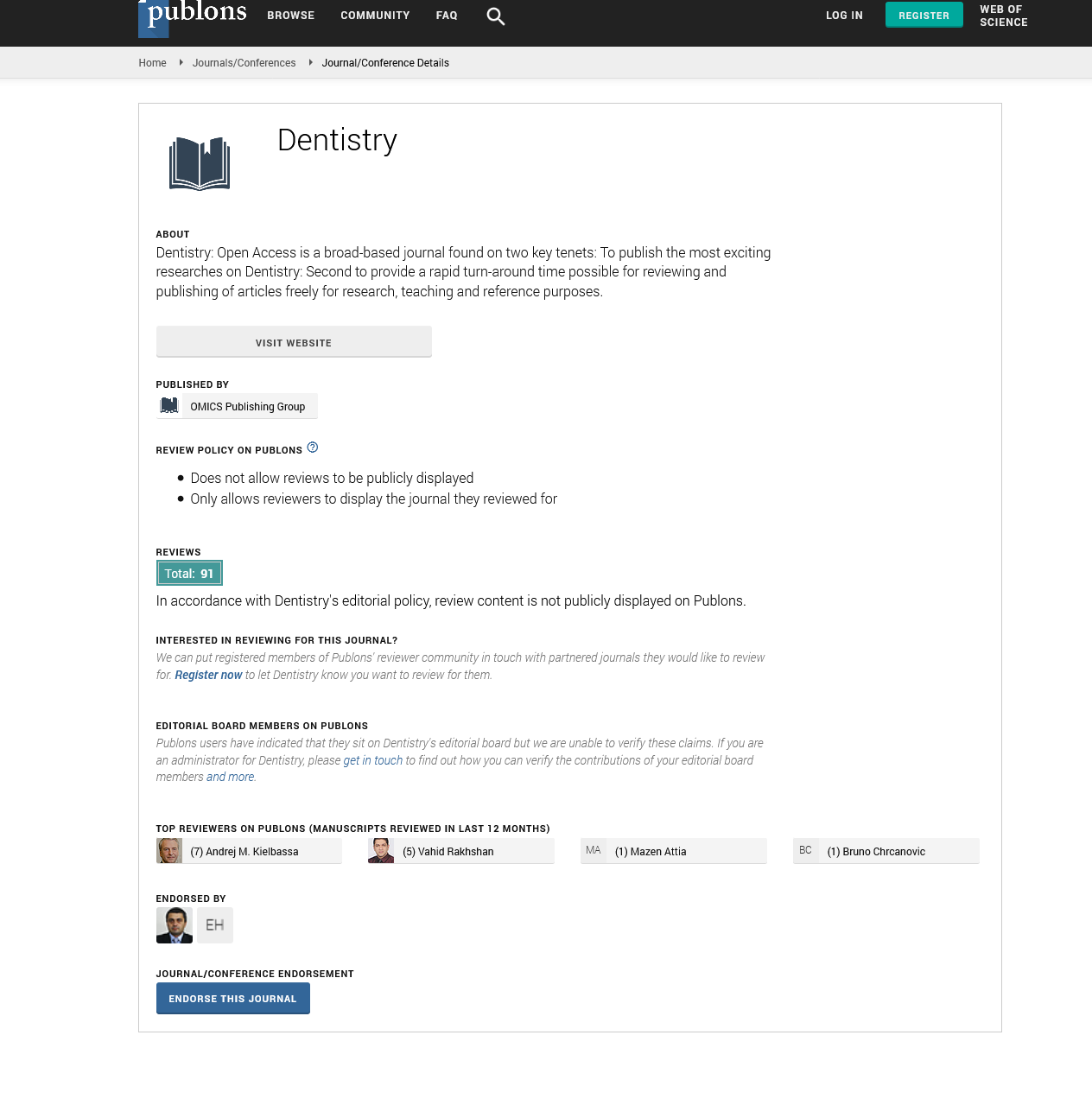Citations : 2345
Dentistry received 2345 citations as per Google Scholar report
Indexed In
- Genamics JournalSeek
- JournalTOCs
- CiteFactor
- Ulrich's Periodicals Directory
- RefSeek
- Hamdard University
- EBSCO A-Z
- Directory of Abstract Indexing for Journals
- OCLC- WorldCat
- Publons
- Geneva Foundation for Medical Education and Research
- Euro Pub
- Google Scholar
Useful Links
Share This Page
Journal Flyer

Open Access Journals
- Agri and Aquaculture
- Biochemistry
- Bioinformatics & Systems Biology
- Business & Management
- Chemistry
- Clinical Sciences
- Engineering
- Food & Nutrition
- General Science
- Genetics & Molecular Biology
- Immunology & Microbiology
- Medical Sciences
- Neuroscience & Psychology
- Nursing & Health Care
- Pharmaceutical Sciences
Perspective - (2022) Volume 12, Issue 7
Dental Computer-Aided Design Applications on Dentistry
Zadik Vander*Received: 21-Jun-2022, Manuscript No. DCR-22-17703 ; Editor assigned: 24-Jun-2022, Pre QC No. DCR-22-17703 (PQ); Reviewed: 08-Jul-2022, QC No. DCR-22-17703 ; Revised: 18-Jul-2022, Manuscript No. DCR-22-17703 (R); Published: 25-Jul-2022, DOI: 10.35248/2161-1122.22.12.587
About the Study
Over the past 25 years, Computer-Aided Design (CAD) and Computer-Aided Manufacturing (CAM) have gained popularity in dentistry. The technology can be used for inlays, onlays, veneers, crowns, fixed partial dentures, implant abutments, and even full-mouth reconstruction. It is employed in both dental laboratories and dental offices. Orthodontics also makes use of CAD/CAM. Three problems were addressed by the development of CAD/CAM technology. Patients can occasionally receive restorations the same day because to CAD/CAM technology. There are many different ways that laboratories and dentists might use the new technology. Dentists can, for instance, create a digital impression and send it to a lab for the creation of restorations, or they can do their own internal computer-aided design and milling. When labs get a digital impression, they can use the data to produce a stone model, then either carry out traditional fabrication as is or rescan the model for milling. As an alternative, the lab can use the photos it receives to perform all of the design work online.
Digital impressions
By employing scanners, digital impressions are a way to capture the contour of a patient's dental structures. In the early stages of CAD/CAM, study models or dental impressions-indirect representations of the patient's dentition-were digitalized using desktop scanners. These tools, which can be either touch or noncontact, are also known as extra oral scanners.
Contact scanners employ stylus profilometers that are pressed up against and moved along an object's edges. A 3D image of the thing is created from the digital point cloud created when the stylus makes contact with the object and is analysed by an internal mathematical algorithm (mesh).
Non-contact scanners use optics, such as light-emitting diodes, to capture the geometry of dental structures. A Charge Couple Device (CCD) or a position sensing detector are typically used as the onboard sensors once light from the scanner strikes the object and reflects into them. As with contact scanners, the scanner may create a 3D representation of the object thanks to these reflections. Structured light, laser light, and confocal microscopy are three different methods through which extraoral non-contact scanners might gather this data. Although contact scanners are more precise than non-contact scanners, they are no longer often used because to their slowness. Additionally, the accuracy required for a successful dental prosthesis is 10 times lower than what these scanners deliver, making them overkill.
Because they may digitalize a patient's dentition immediately in the mouth, as opposed to initially requiring the creation of a plaster study model or a traditional dental imprint as is the case with extraoral scanners, intra-oral scanners, a type of noncontact scanner, have gained popularity. As a result, the creation of dental prostheses can be done entirely digitally from the beginning. The buildings that were to be scanned must all is covered in contrast powder for older scanners, but not for newer models.
Materials used in CAD/CAM
The materials used are always changing because CAD/CAM is a technology that is rapidly developing. CADCAM software can currently be used to create a variety of materials, including metals, porcelain, lithium disilicate, zirconia, and resin materials. Restorations created with CAD/CAM are milled from solid ceramic or composite-resin blocks. If pre-sintered ceramic ingots are utilised, additional sintering will be necessary to decrease porosity, and the CAD-CAM technology will need to take any casting shrinkage into account. Utilizing CAD-CAM, glass-based restorations can also be produced. Glass ingots are ground, and molten glass is injected to minimise porosity, much like ceramics. The benefit of CAD/CAM materials is the consistency in restoration quality when mass produced.
Citation: Vander Z (2022) Dental Computer-Aided Design Applications on Dentistry. J Dentistry. 12:587.
Copyright: © 2022 Vander Z. This is an open access article distributed under the terms of the Creative Commons Attribution License, which permits unrestricted use, distribution, and reproduction in any medium, provided the original author and source are credited

